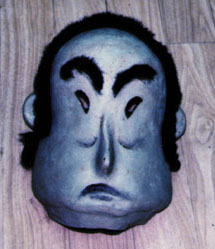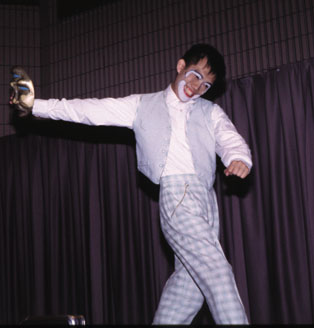 Silence on the stage
Silence on the stage


 Silence on the stage
Silence on the stage
A wordless play carrying deep thoughts
By Shirley Lau
 H
ere in the Cultural Centre, a performance was taking place. Two actors were swinging their arms, nodding their heads and smiling at the audience. However, the only sound heard in the whole theatre was the laughter from the audience.
H
ere in the Cultural Centre, a performance was taking place. Two actors were swinging their arms, nodding their heads and smiling at the audience. However, the only sound heard in the whole theatre was the laughter from the audience.
This was because the performance was not an ordinary drama. It was a mime.
Mr. Wong Kwok Chung, 35, is the artistic director of Mime Touch Theatre and has been acting in mime for 10 years.
He said, “Many years ago, in European countries like Italy, kings prohibited people from spreading alternative political and religious ideas in public. Therefore, people could only express anything they wanted to say by acting without speaking. Such kind of performance is what we now call ‘mime’.”
Apart from the silent performance, the costumes and props used in mime are other distinctive features of this form of drama.
“It is a tradition that actors of mime wear black clothes. This is because clothes in bright colours will distract the audience’s attention from the performance. Besides, the white faces of the actors produce a contrast to the black clothes, while tight clothes make actors’ movements distinctive,” said Mr. Wong.
Before Mr. Wong became a professional mime, he worked at a monthly magazine company and was a part-time mime. Having greater interest in mime, he later decided to quit his job and devoted all his time to the art.
“Mime allows me to convey my feelings and thoughts more. Drama may not necessarily do that. Very often, human thoughts and sensations cannot be expressed simply by language,” said he.
According to Mr. Wong, skills and ideas are two important elements of mime. However, he said ideas are a little bit more important because without good ideas in a mime, the performance will be nothing, no matter how talented the actors are.
On the other hand, the qualities a good mime actor should possess are creativity, courage to try to do different things and rich life experience.
Mr. Wong added that most of the local audience consider mime like caviar.
Said he: “Many of them think that mime is boring and difficult to understand. Some of them cannot even distinguish mime from clown performance.”
Mrs. Lee Lai-yu, a housewife from Kowloon Bay, brought her 8-year-old son to watch mime. She encouraged her son to go on stage to play with the actors after one part of the show.
She said, “I don’t quite understand what the actors are doing, and I find it quite boring. However I enjoyed the part when the actors played with the children. I let my son play with them to encourage him to be more active.
“If the performance had been purely a mime without the participation of children in the middle of it, I don’t think I would have gone on watching it. Perhaps I am not well-educated enough to appreciate its meaning.”
Mr. Wong explained, “If the audience has a little more patience in watching mime, they will be able to catch the ideas expressed by actors’ facial expressions and body movements. Such a comprehension is an interesting process.”
Mr. Wong’s group has now been trying to promote mime to the general public by performing frequently in places like discos, restaurants and even on the streets.
Said Mr. Wong: “I can see that the audience’s ability to appreciate mime has gradually been enhanced.”
A part-time mime actress, Miss Yip Wai-Shan, told how she maintained her job and her interest together. “As a journalist, I am very busy. But since I am very interested in mime, I try to arrange some time for it.
“I am more interested in mime than drama, because acting in mime allows me to express my thoughts and feelings more deeply.
“Mime requires a lot of imagination from the performers. For instance, when the story in a mime is about a forest, I have to imagine there are trees on the stage. It is not easy to do so. In order to do my best, I often face a mirror to practise my facial expression and body movement,” she said.
Mr. Lartier Marot, a businessman from France, passed by the Cultural Centre and was attracted by the performance. He said, “I think mime is very difficult to perform because it is make-believe.
“In my home country, mime is quite a popular form of art. Indeed, I am a bit surprised to learn that there are mime groups in Hong Kong. I thought Hong Kong people were not interested in it.”
A young mime lover, Mr. Alfred Chiu, said, “I had been actively participating in drama performances at school, but never acted in a mime. Out of curiosity, two years ago during a summer vacation, I took a course in order to enrich my experience in acting.
“After taking the course, I found that mime was more than facial expressions and body movements. Every movement of a mime represents his or her emotions and sensations and the thoughts he or she wants to express,” said the Form 7 student.
Unfortunately, he met parental pressure. “I want to be a professional mime, but my parents say I can’t make a living by that, and they want me to study in a university. I don’t know if there is any way I can realise my dream and satisfy my parents at the same time,” he said.
According to Mr. Wong, Mime Touch Theatre and some other mime groups constantly offer “workshop training” for anyone who is interested in mime.
“In the workshops, participants are taught the skills of mime, and they may create stories of their own. After the training, if they are interested, they are welcome to join our group and take part in our performances in future,” said he.


